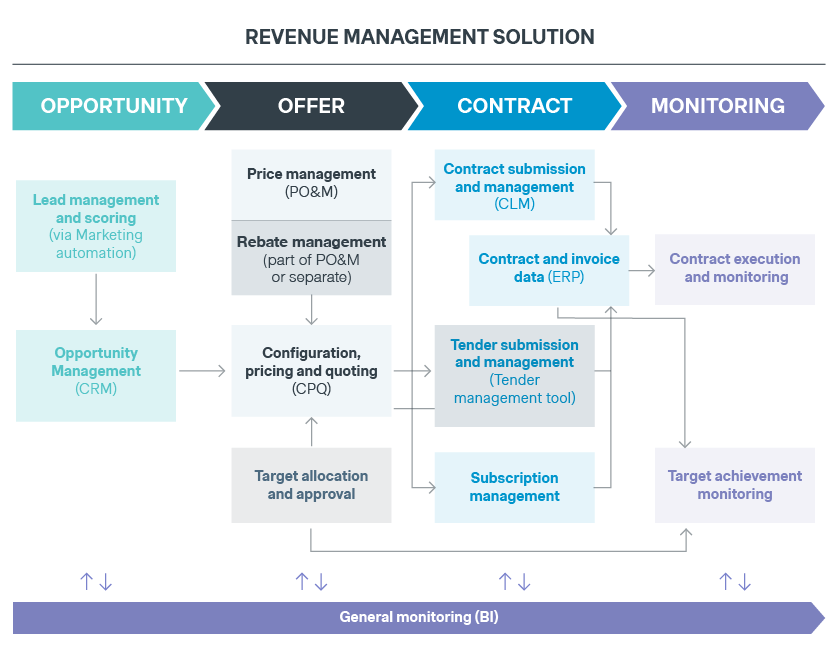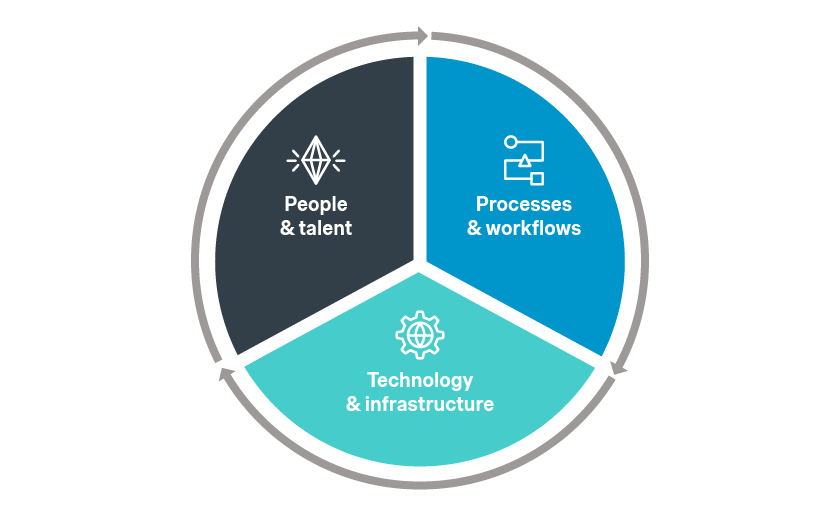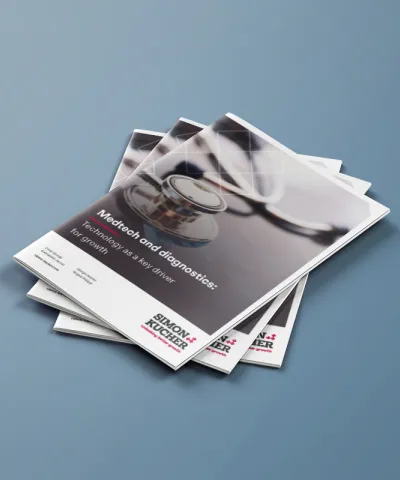In healthcare, the pursuit of financial stability intersects with the mission to deliver superior patient care. This is where Revenue Management Systems (RMS) can serve as transformative forces, redefining how medtech and diagnostic entities maximize revenue streams and operational efficiency.
Late last year, we published our paper on RMS in healthcare: Unlocking growth in medtech with Revenue Management Systems. The paper explains our framework, discusses key applications and concrete use cases for healthcare companies, and dismisses common myths around this topic.
Building on this foundation, in 2024 we will be adding more depth, additional insights, and sparking new ideas around the topic. Welcome to our new series: Embracing end-to-end revenue management in medtech and diagnostics. Here we will explore the commercial opportunities of RMS, including insights from industry leaders on how to best navigate and mitigate common breakpoints in implementations, as well as narratives of both triumphs and setbacks.
Introduction to revenue management systems (RMS)
What are revenue management systems?
They are sophisticated, integrated solutions designed to optimize and automate the entire revenue cycle within an organization. Often, they are not single software solutions but rather an intricately woven architecture of specialist applications, each contributing to the seamless functioning of the entire enterprise.
Throughout the series, we will explore the pivotal roles played by:
- Customer relationship management (CRM) systems in driving opportunity and lead management.
- Configure, price, quote (CPQ) and price optimization and management (PO&M) systems in orchestrating quoting and pricing.
- Contract lifecycle management (CLM) systems in streamlining contract processes.
- Business intelligence (BI) tools embedded in these systems providing analytical insights that redefine commercial success in healthcare.
Yet, RMS goes beyond IT systems; making these systems work seamlessly is more of an art. Throughout this series, we look beyond technology, shedding light on the indispensable role of the people, processes, and governance involved. These elements are just as crucial, if not more so than the tools themselves.
That’s why we will be sharing a comprehensive, integrated view of how RMS operates and how to achieve success.
This series is tailored for all commercial, digital, and technology leaders in medtech and diagnostics companies, providing a holistic perspective on the transformative potential of RMS. Stay tuned for insights that go beyond the surface, unlocking the keys to success in the dynamic landscape of healthcare.
Structured to reflect our RMS framework, this series defines the four stages of RMS and the corresponding technology that supports it.

The four steps for success with RMS in medtech and diagnostics
Opportunity: Generating and managing leads
In part one, we explore how best-in-class players identify, nurture, score, and route leads and how they turn leads into opportunities. We discuss how medtech and diagnostic players can go from simply having a CRM system for recording purposes to effectively using it to add value. This step is supported by Customer Relationship Management (CRM) applications and Marketing Automation suites (MA).
Offer: Configuring offers that drive profits
Part two covers a core step for successful RMS, as it has the most profound impact on improving revenue management and driving profits. We explore how best-in-class players set up their pricing and trade terms and how they use technology to implement these changes. We also investigate how medtech and diagnostic companies can supercharge their offer, quoting, and sales processes with CPQ applications and the organizational changes needed to ensure sustainable impact.
Contract: Future proof your contracting setup
Contracts are highly relevant for medtech and diagnostic companies, who often sell a combination of a device and consumables (e.g., reagents or similar). A contract will hold the agreed-on price for these devices and consumables and is used to determine order conditions. In part three of this series, we explore best practices for a future-proof contracting setup – an area where many companies have a long way to go especially in sectors where the majority of sales are on long-term contracts. Moreover, we address how to properly integrate your contract management with sales systems and quoting to ensure a full, end-to-end integrated workflow and customer experience. We show how these can be handled by a well-functioning CLM system to prevent margin leakage and ensure full value capture of your contracts.
Monitor: Ensuring transparency and governance
In the final part of the series, we explore how modern BI solutions, either standalone or built into the tools, help to ensure transparency and governance across the entire RMS cycle – from analyzing the lead pipeline, through having a good handle on trade term exceptions, to making sure that contract fulfillment (or unfulfillment) is properly monitored and handled.
CRM, CPQ, PO&M, CLM systems, and BI tools – understanding these tools is important to paint a clear picture of how revenue management systems are redefining commercial success in healthcare. However, it is essential to recognize that RMS is not solely about technology. The success of these systems hinges on the interplay between technology, people, and processes.

That’s why, throughout the year 2024, we will look beyond (but not past) the technology and discuss all three key elements that drive the success of RMS: technology, people, and processes.
- Which organizational changes are necessary and what types of skills must your organization have or acquire to implement RMS? We discuss how our clients have handled such challenges in the past and what key learnings you can take away and implement in your organization.
- We also look into how the right processes and workflows form a firm foundation for RMS success. We explain why, without the right processes, technology will never deliver on its promises.
- Supported by real-world examples and case studies, we showcase approaches from companies that have built strong foundations. We also investigate cases where the foundations were frail and brittle, with strategies to avoid these situations.
Spoiler alert: In our experience, RMS can rarely be successful unless all parts – both the technology and the commercial foundation – are perfectly in sync and support each other.
We firmly believe that this is what separates our approach to RMS from the mainstream in the market: we intelligently combine business and technology into one cohesive and integrated entity.
We know the recipe for success with revenue management systems
For more than 35 years, Simon-Kucher has provided clients in the healthcare and life sciences industries with unparalleled and pragmatic commercial advice on pricing, market access, and trade terms. We bring the same pragmatism to designing and implementing RMS solutions for our clients. We know how to separate the wheat from the chaff because we understand what matters:
Seamless user experience
Technology is only useful if it provides a seamless user experience. In one of our projects, we designed a full quoting user experience for a mid-sized healthcare provider by intelligently combining different pieces of RMS to seamlessly support a highly complex, self-pay quoting process. Our client considered the solution to be a transformational in their digitalization journey as it significantly improved overall user adoption.
Coverage of the right business use cases
Every business is different, and so is medtech and diagnostics. We don’t need to compromise on the functionality due to technical limitations, but we also don’t need to cover 100% of use cases every time. We often advise our clients to use RMS for the core business only, as there is no need to automate everything immediately.
Design with scalability in mind
The solutions we design ensure relevance not only today, but also tomorrow. This includes when our client’s business grows or expands to other horizons. In another project, we were tasked with reviewing a large medical device manufacturer’s pricing and contract approach as well as designing their North Star and target technology architecture. We approached this by understanding how the client operates today, but also considered foreseeable changes in the market to ensure that the target state will serve the client well for years to come.
Speed-to-implementation
This is a critical imperative for successful project execution. Rapid prototyping is at the forefront of this strategy, allowing organizations to swiftly develop and deploy solutions, ensuring that users have tangible tools and features at their disposal promptly. Beyond merely delivering solutions quickly, the focus is on proving their value in a relatively short timeframe and working with decision makers to increase the speed of adoption.
Intelligent use of AI/ML
Although these technologies are pervasive and can support every aspect of the RMS journey, it's essential to recognize that sometimes less is more. For many healthcare companies, prioritizing the resolution of fundamental issues holds greater significance and generates more value than incorporating AI and ML merely for the sake of doing so. We understand when to make the call for the most impactful results; If done right, AI and ML can provide tremendous value in any of the four pillars of RMS. As an example, we developed a dynamic pricing solution including an algorithm based on machine learning for a large regional consumer healthcare player that significantly improved their bottom line in comparison to previously used approaches.
Technology should follow business and not the other way round. It seldom occurs – if at all – that a technology alone drives and creates lasting impact in an organization. In our view, this is the key reason why so many implementations fail or do not bring the desired outcome.
Stay tuned for an exciting year and feel free to contact us at any time to discuss RMS in more detail.
Thanks to our contributor: Angela Philippi



